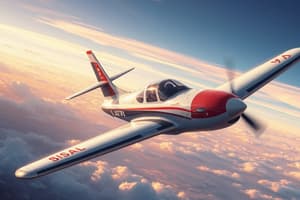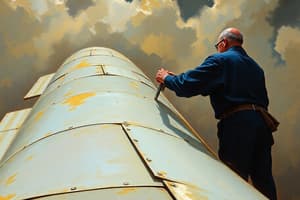Podcast
Questions and Answers
What is one of the primary purposes of aircraft coverings and finishes?
What is one of the primary purposes of aircraft coverings and finishes?
- To decrease the structural integrity of the aircraft
- To enhance the aesthetic appeal of the aircraft (correct)
- To make the aircraft harder to maintain
- To increase the weight of the aircraft
Which material was commonly used in early aircraft coverings?
Which material was commonly used in early aircraft coverings?
- Composite materials
- Aluminum
- Fiberglass
- Doped linen (correct)
What advancements have influenced modern aircraft coverings?
What advancements have influenced modern aircraft coverings?
- Complex maintenance requirements
- Increased fuel consumption
- Use of heavier materials
- Greater durability and performance (correct)
How do smooth coverings and finishes benefit aircraft performance?
How do smooth coverings and finishes benefit aircraft performance?
What type of environmental threats do aircraft coverings help protect against?
What type of environmental threats do aircraft coverings help protect against?
What benefit do modern composite materials provide over traditional materials?
What benefit do modern composite materials provide over traditional materials?
What has been a significant outcome of advancements in aircraft covering materials?
What has been a significant outcome of advancements in aircraft covering materials?
Which factor is NOT a benefit of modern aircraft coverings?
Which factor is NOT a benefit of modern aircraft coverings?
What was the main purpose of treating fabrics with dope on early aircraft?
What was the main purpose of treating fabrics with dope on early aircraft?
Which materials were primarily used for the structural framework of early aircraft?
Which materials were primarily used for the structural framework of early aircraft?
What benefit did aluminum alloys provide in aircraft construction during the World Wars era?
What benefit did aluminum alloys provide in aircraft construction during the World Wars era?
What was a primary reason for the development of high-performance coatings and finishes?
What was a primary reason for the development of high-performance coatings and finishes?
Which of the following was a key consideration for early aircraft design?
Which of the following was a key consideration for early aircraft design?
What feature characterized the finishes on wood and metal structures of early aircraft?
What feature characterized the finishes on wood and metal structures of early aircraft?
In addition to performance enhancements, what was another advantage sought through the development of durable paints and primers?
In addition to performance enhancements, what was another advantage sought through the development of durable paints and primers?
What was the main focus of advances in metal construction during the era of early aircraft?
What was the main focus of advances in metal construction during the era of early aircraft?
What is one significant disadvantage of fabric coverings compared to metal or composite structures?
What is one significant disadvantage of fabric coverings compared to metal or composite structures?
Which of the following is a key property of composite coverings?
Which of the following is a key property of composite coverings?
What maintenance issue is associated with metal structures?
What maintenance issue is associated with metal structures?
What is one advantage of using aluminum alloys for aircraft coverings?
What is one advantage of using aluminum alloys for aircraft coverings?
What does the primer do before applying paint to aircraft materials?
What does the primer do before applying paint to aircraft materials?
What environmental factor can significantly degrade fabric coverings over time?
What environmental factor can significantly degrade fabric coverings over time?
What is a potential outcome of using composites in aircraft design?
What is a potential outcome of using composites in aircraft design?
What was the main focus during the World Wars era regarding aircraft materials?
What was the main focus during the World Wars era regarding aircraft materials?
Which material is NOT commonly used for fabric coverings in light aircraft?
Which material is NOT commonly used for fabric coverings in light aircraft?
Which maintenance action is necessary for ensuring the integrity of fabric coverings?
Which maintenance action is necessary for ensuring the integrity of fabric coverings?
What advantage do metal coverings provide for aircraft?
What advantage do metal coverings provide for aircraft?
What is a characteristic of modern aircraft materials compared to those used in earlier eras?
What is a characteristic of modern aircraft materials compared to those used in earlier eras?
Which advantage is primarily attributed to fabric coverings in light aircraft?
Which advantage is primarily attributed to fabric coverings in light aircraft?
What challenge is associated with using composite materials in aircraft?
What challenge is associated with using composite materials in aircraft?
Which of the following is an advantage of using aluminum alloys in aircraft?
Which of the following is an advantage of using aluminum alloys in aircraft?
What is a disadvantage of fabric coverings compared to metal or composite structures?
What is a disadvantage of fabric coverings compared to metal or composite structures?
What is one primary purpose of aircraft paint?
What is one primary purpose of aircraft paint?
Which type of weave is known for being less tear-resistant but inexpensive?
Which type of weave is known for being less tear-resistant but inexpensive?
What is the function of a sealant in aircraft construction?
What is the function of a sealant in aircraft construction?
What is a major consideration when using composite materials in aircraft construction?
What is a major consideration when using composite materials in aircraft construction?
What role does a primer serve in aircraft finishes?
What role does a primer serve in aircraft finishes?
Why is aerodynamics important in aircraft design?
Why is aerodynamics important in aircraft design?
What is a disadvantage of using composite materials in aircraft manufacturing?
What is a disadvantage of using composite materials in aircraft manufacturing?
What is an essential safety function of aircraft sealants?
What is an essential safety function of aircraft sealants?
Flashcards are hidden until you start studying
Study Notes
Purpose of Aircraft Coverings and Finishes
- Protect aircraft from environmental elements like rain, snow, hail, and UV radiation.
- Improve aerodynamic efficiency by reducing air resistance (drag).
- Enhance the aesthetic appeal, contributing to the aircraft's overall visual impact.
Evolution of Materials and Techniques
- Early aircraft utilized lightweight fabric coverings (doped linen, cotton) but were vulnerable to weather degradation.
- Advancements led to metal constructions, primarily using aluminum for increased strength and durability.
- Modern aircraft incorporate advanced composite materials with superior strength-to-weight ratios, enhancing performance and efficiency.
Protection from the Elements
- Coverings prevent corrosion and structural weakening from harsh weather.
- Innovations in materials have transitioned from fabric to metal to composites for improved protective capabilities.
Aerodynamic Efficiency
- Smooth and efficient coverings significantly minimize drag, resulting in lower fuel consumption and enhanced range.
- Advanced coatings and finishes contribute to superior aerodynamic profiles in modern designs.
Early Aircraft Construction
- Early structures were primarily made from wood and sometimes reinforced with metals.
- Fabric coverings initially provided minimal protection, focusing on structural needs rather than aesthetic enhancements.
World Wars Era
- Advancements in metal construction included extensive use of aluminum alloys for their lightweight and strong properties.
- Development of durable paints and primers aimed at improving corrosion resistance and enhancing overall durability for military aircraft.
Modern Era Developments
- The introduction of composite materials such as carbon fiber and fiberglass has revolutionized aircraft design.
- These materials are pivotal for meeting present-day demands for efficiency, performance, and passenger comfort.
Types of Aircraft Coverings
- Fabric Coverings: Common in light and vintage aircraft, often made from Dacron for strength and lightness.
- Metal Coverings: Primarily aluminum, known for structural integrity and corrosion resistance.
- Composite Coverings: Made of various materials, including fiberglass and carbon fiber, offering lightweight and high strength.
Advantages and Disadvantages of Covering Types
-
Fabric Coverings:
- Pros: Lightweight, easy to repair, good performance.
- Cons: Less durable, susceptible to weathering and damage.
-
Metal Coverings:
- Pros: High durability, excellent structural strength, corrosion-resistant.
- Cons: Manufacturing complexity, risk of fatigue from repetitive stress.
-
Composite Coverings:
- Pros: Lightweight, high strength, design flexibility.
- Cons: Typically more expensive to produce and require specialized manufacturing.
Purpose and Types of Aircraft Finishes
- Primer: A foundational protective coat applied before other finishes, prevents corrosion and aids aerodynamics.
- Paint: Enhances aesthetics, provides identification, and protects from weathering and UV radiation.
- Sealants: Fill gaps to prevent moisture intrusion and protect internal structures from corrosion.
Fabric Construction and Properties
- Various weaves (plain, basket) provide different strengths and resistance to tearing and are chosen based on specific structural requirements.
Studying That Suits You
Use AI to generate personalized quizzes and flashcards to suit your learning preferences.





